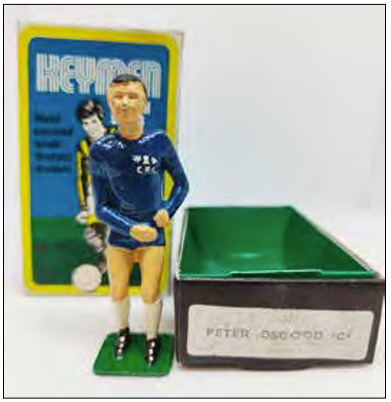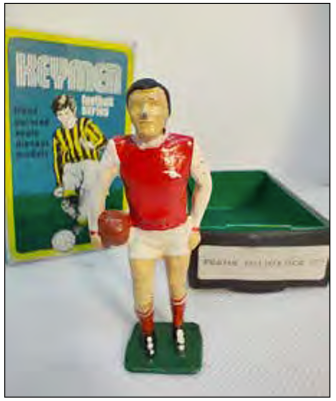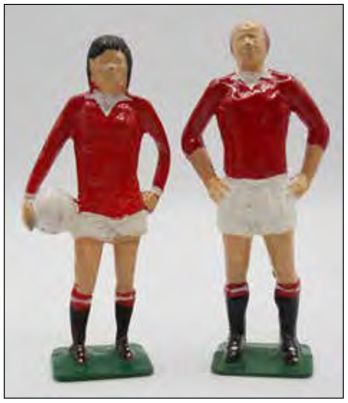Association Football, the formal term for Soccer, has had its fair share of recognisable characters over its long history and in the early 1970s a small, short-lived company proved it.
KEYMEN Miniatures Ltd was founded by Mr David Mitchell around the mid to late 1960s. Another director, Mr Wilson B. Platt, was astute enough to leave a note giving a rundown of the company’s brief history which forms the basis of this article.
The original idea was for KEYMEN to produce historical figures and Arthur Wellesley, first Duke of Wellington, was even considered.
Two figures were produced in white metal, supposedly Pope John XXIII in a very large 1/9th scale and John F Kennedy in 1/27th scale (the same scale as the soon to be produced footballers), around 65mm (2 ½”). The Pope and the President both died in 1963 which is probably why they sprang to mind to Mr Mitchell and Mr Platt at the time. Both of these figures have yet to come to light, unless you have an 8” model of a Pope at home!
But historical figures weren’t new, so the idea of sportsmen was considered and with England the World Soccer Champions, and the new World Cup competition impending in 1970, the company made the decision to produce footballers.
The figures were diecast in white metal. The sculptor is unknown, but the figures managed to be easily recognisable by the stance and individual traits of each player.
They were originally diecast in Manchester and hand painted by prisoners at Strangeways prison (now known as HMP Manchester, which sadly has no records from that period) and later in HMP Preston. Hence, supposedly, KEYMEN.
KEYMEN footballers were launched early in 1970 from Sale in Cheshire, England but the casting was probably done at the company’s next listed address in Wilmslow Road, Manchester.
Painting was also done at Walton Prison (now known as HMP Liverpool) in a building called the Romney Shop.
According to the Governor, when asked in 2007, the prisoners also painted “garden gnomes, cowboys and soldiers”, but for which company is not known.
The figures were distributed from Mr Michell’s home in Sale. They used local wholesalers such as Nolans of Urmston (a confectionary supplier, Fig 1) and Carson of Palatine Road, Manchester (Fig 2). One, Crewe Sales Company run by Kenneth H Crewe, were “sole wholesale agents”, (Fig 3).
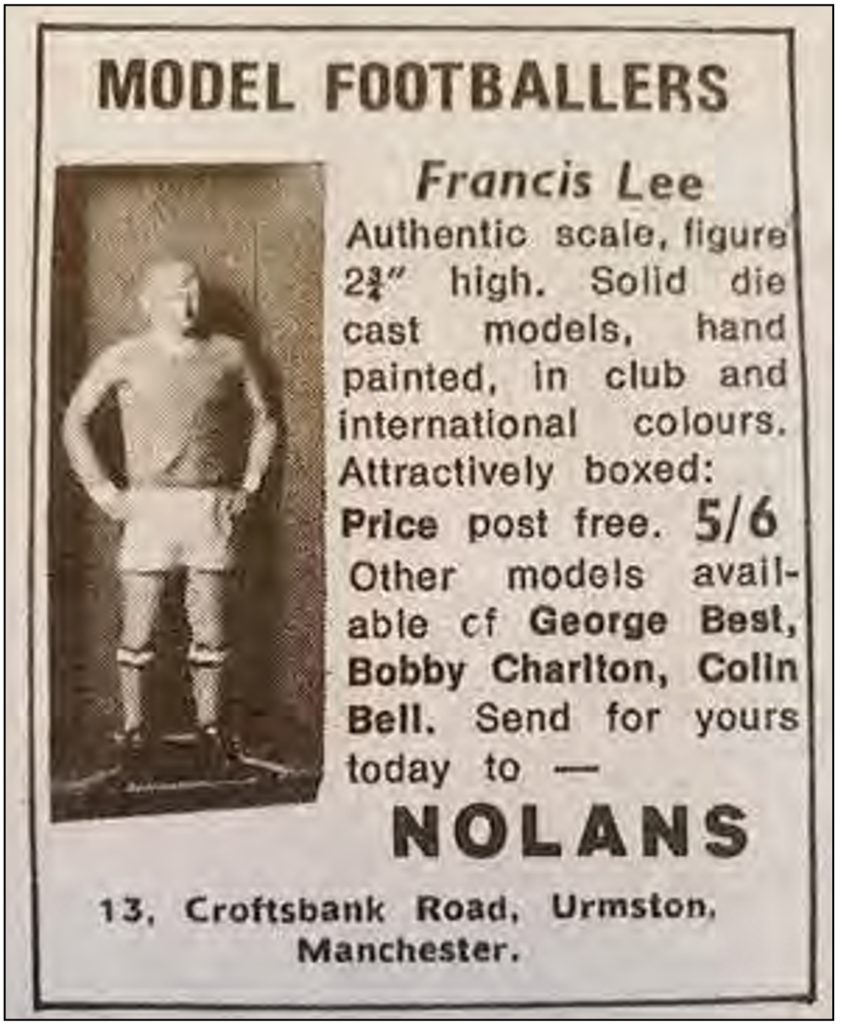
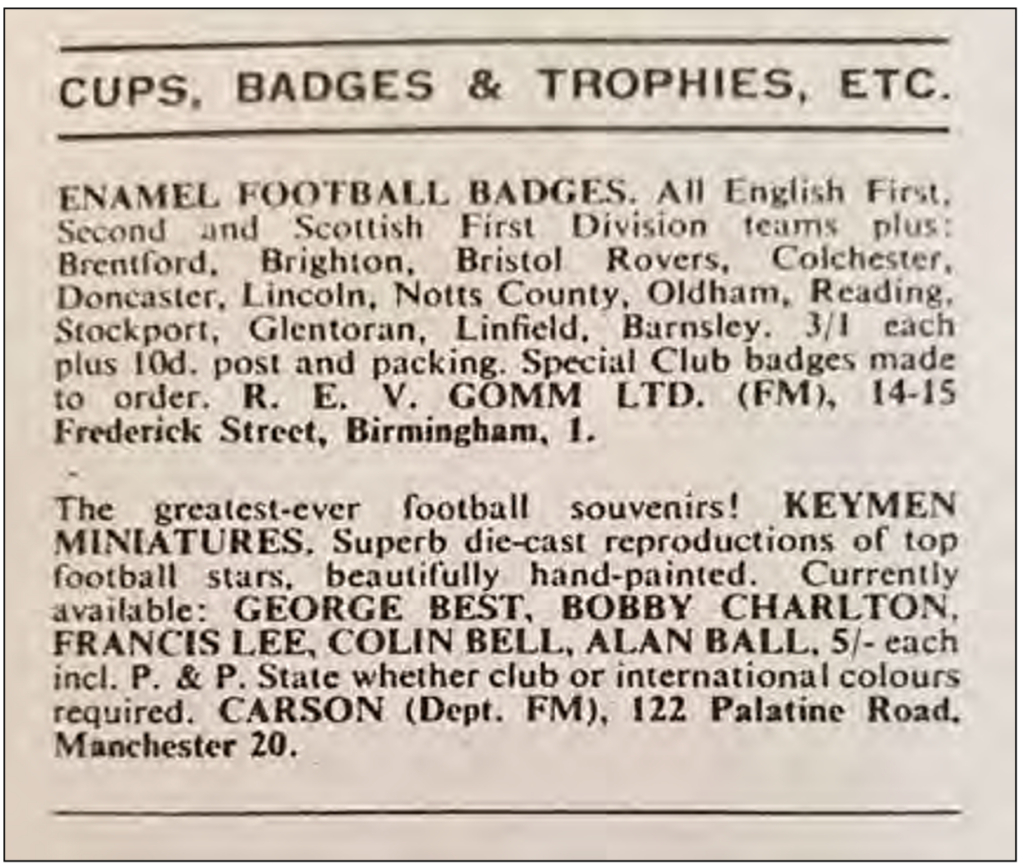
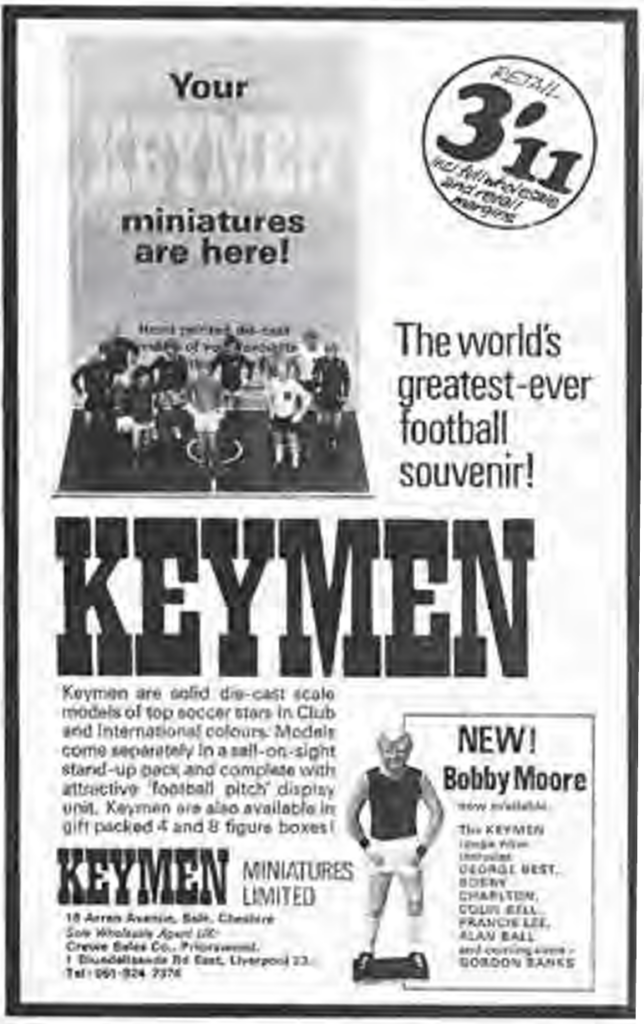
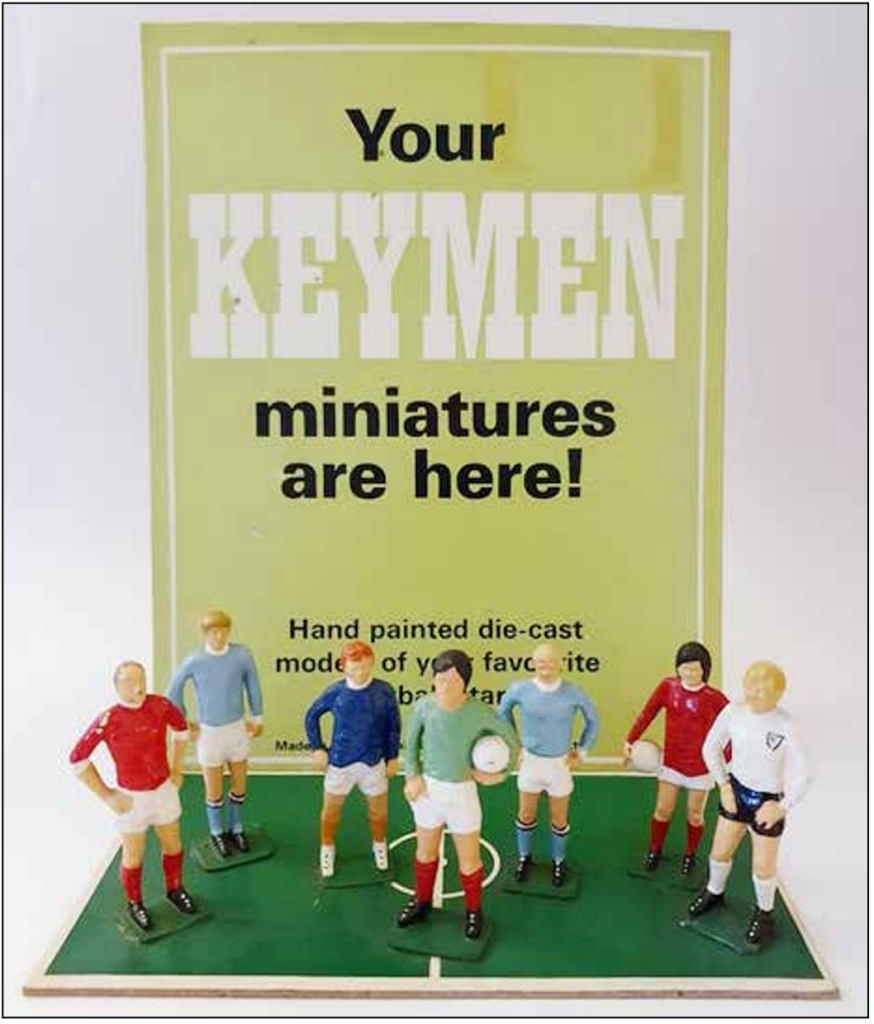
Shops and wholesalers were supplied with an attractive display stand, approximately 230mm high (9”), to display the current figures standing on a football pitch, (Fig 4).
The figures retailed at 3/11 (22c) and came singly in a white box with lift off lid and wrapped in tissue paper with the player’s name on the end of the box (Fig 5). These boxes were used for a very short period, in fact only the first two players have been found in them, so possibly could have been a sample box and they are rare.
The next box was also white but this was much like a large matchbox where the inside drawer had an insert with a cut out at the bottom where the figure could “stand alone” and be displayed and the outside sleeve was white, (Fig 6). The white sleeve had stamped on it the player’s name, sometimes the strip, i.e., international or club, and the model number. It tends to be very faint.
The next box used for the single f igures was a blue and yellow sleeve with a drawing of a player on the front and more importantly, listed all 11 players in the series on the back. It does state “All available in Club and International Colours” which sadly never materialised, (Fig 7).
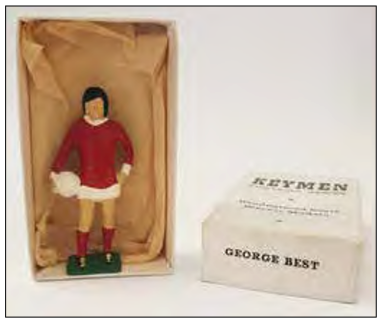
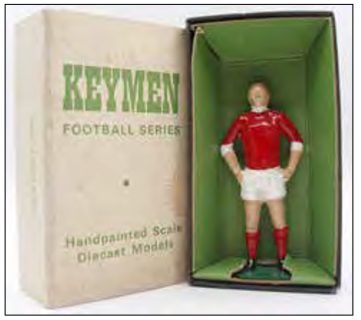
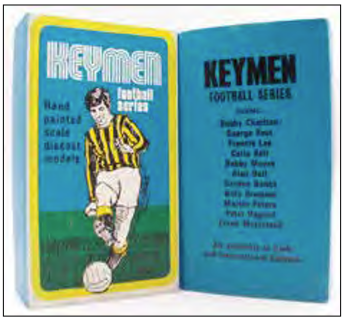
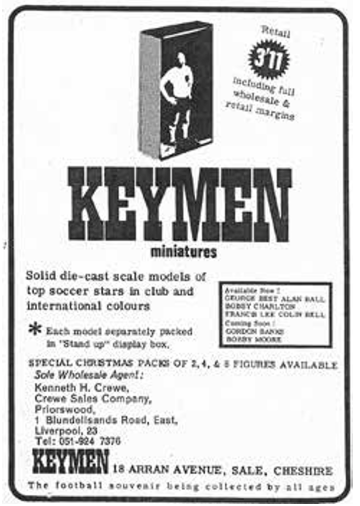
Early advertising (Fig 8) indicated that there would be Christmas packs of 2, 4 and 8 figures alongside the individual boxes but a box of two has never come to light. Boxes of 4 were always available, firstly red (Fig 9), then an orange pack that was short-lived with a cellophane front, (Fig 10). This was followed by a box with similar colouring to the individual blue box which evolved around the same time, (Fig 11).
These 4 packs had sets listed on the back, Northern Famous Four, Southern Famous Four and International Famous Four, but these were not adhered to and almost any selection of four could be found depending on availability.
Boxes of 8 were produced (Fig 12) but were short lived and are rare. GMS advertised four figures for 75p (90c), after decimalisation in February 1971, in club or international strips, (Fig 13). Single figures were now 19p (22c).
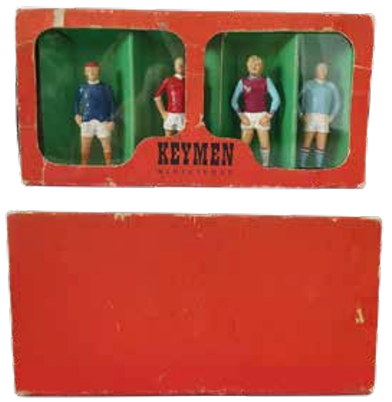
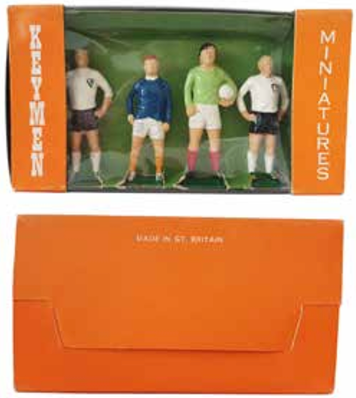
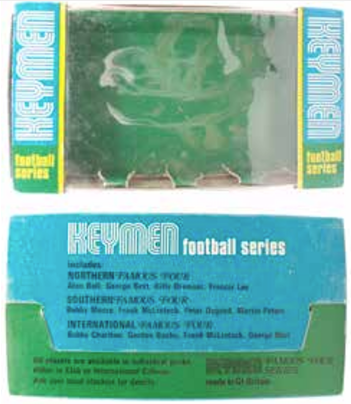
Model No.1 was George Best, a Manchester United and Northern Ireland International player, (Fig 14). As KEYMEN required, the player is instantly recognisable, the sculptor had worked his magic. George’s International shirt with the badge missing proves that painting errors would occasionally happen, (Fig 15).
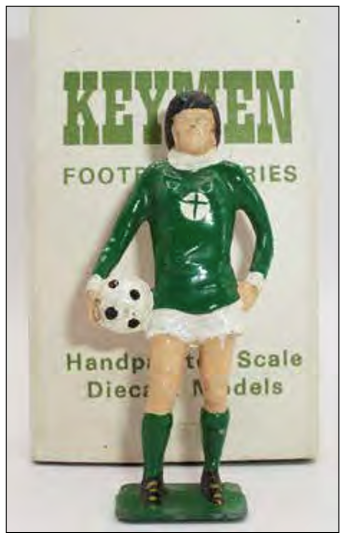
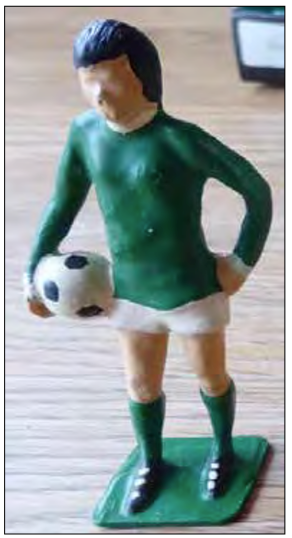
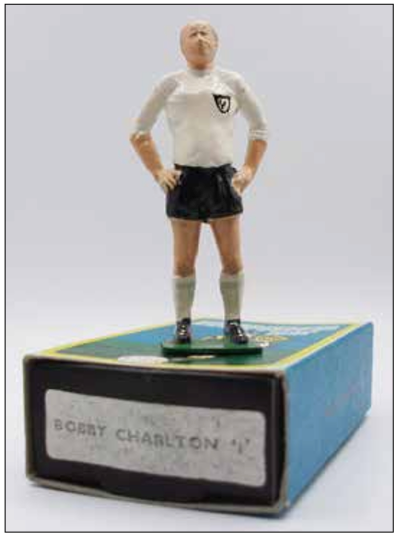
Model No.2 was Bobby Charlton, also of Manchester United and an England International, accurate even down to his lack of hair, (Fig 16)!
Colin Bell was the third model. A Manchester City and England International player, he can be found in both strips, as can his team mate, model No.4, Francis Lee, (Figs 17-20).
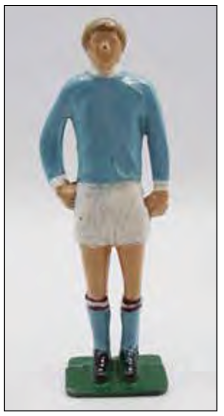
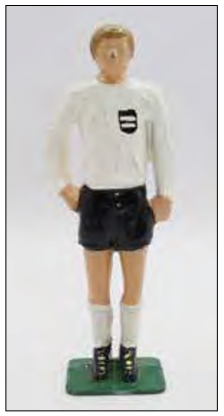
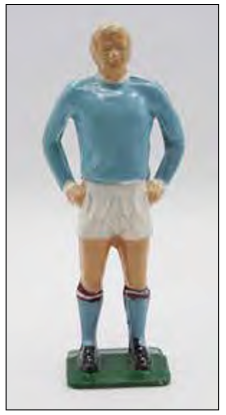
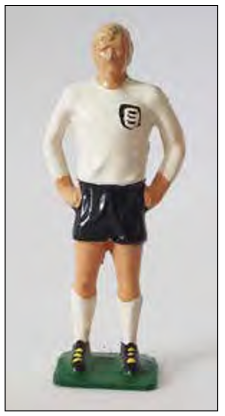
KEYMEN did produce these two players in their Club Away Team colours of red and black stripes and used them in advertising but these are uncommon, (Fig 21). Manchester City have a pair in their Archive, (Fig 22). Repaints are usually available of these figures.
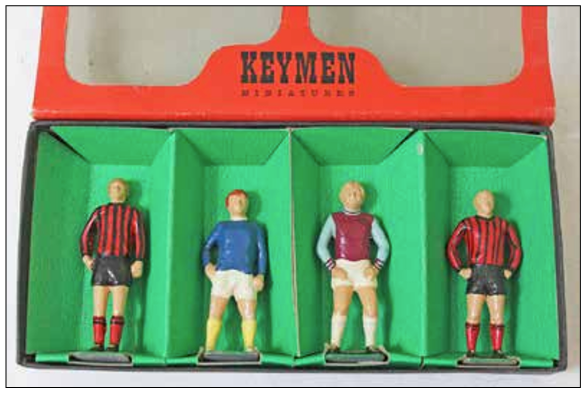
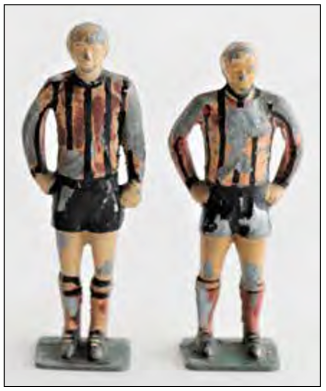
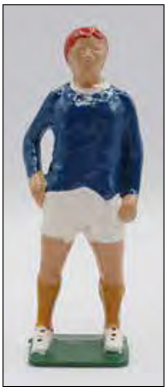
Alan Ball, number 5, is a bit of a rarity as a KEYMEN player. During the figures production period, Alan transferred to different teams. He started off as an Everton player (Fig 23), he was also an England International, and in December 1971 he became an Arsenal player, (Fig 24). Alan was also the first player in England to play in white boots.
So KEYMEN had him painted with white boots in his Everton kit but black boots in his Arsenal kit. There are a few white booted Arsenal kitted Alan Ball f igures out there, but they are rare, (Fig 25).
Bobby Moore, West Ham United and England’s captain came next and probably intentionally, as No.6 was his usual shirt number for club and country, (Fig 26). Bobby had captained England to their only ever World Cup win at Wembley, London in 1966 and was heading for Mexico to be England’s captain again in 1970.
8 of the eventual 11 KEYMEN figures were from England’s 1970 squad including Model No.7, Gordon Banks, (Fig 27). Goalkeeper Gordon, like Moore, Charlton, Ball and Peters (Model No. 9), had been a World Cup winner in 1966 and was also heading for Mexico. He can be found in his Stoke City FC kit and his international strip. Gordon’s first-class career ended when he was blinded in one eye after a car accident in October 1972.
Later models, probably number 8 onwards, were diecast in Pontefract, West Yorkshire and were fettled in HMP Wakefield. The figures were then “spray painted” and boxed in HMP Kirkham and then distributed from Mr Mitchell’s home in Sale, with reports of the figures being driven to London to stockists there. Sadly, HMPs Wakefield and Kirkham have no records from the period.
These later models were only to be found in club colours and nowadays tend to be the harder ones to find, especially in good condition. These later figures are prone to diecast cracking probably due to the materials’ quality, possibly after the move to Pontefract.
Model 8 was Billy Bremner, captain of Leeds United (Fig 28) and would only be found in the later “blue” boxes. Although a Scotland International, KEYMEN never had him painted as an International player, but some collectors, usually using cracked versions, repair and repaint Billy in the historically correct Scotland colours. Model No. 9 was Martin Peters (Fig 29), then playing for Tottenham Hotspur FC, having transferred from West Ham Utd in 1970. Peters, one of the goal scorers in the 1966 World Cup final, was again in the England squad heading for the Mexico finals.
Model No. 10 was Peter Osgood of Chelsea FC, (Fig 30). Peter, a very difficult figure to find in any condition, was also an England International and was the 8th of the KEYMEN players going to the next World Cup.
The Holy Grail for KEYMEN collectors is the final model produced, Frank McLintock, (Fig 31). Frank was captain of Arsenal FC’s League and FA Cup double winning side of 1972 and a Scottish International. Frank is the rarest KEYMEN figure. Like the Osgood model, condition was suffering. The quality of the materials used had been deteriorating and it appears there was dissention between the company and the casting manufacturers.
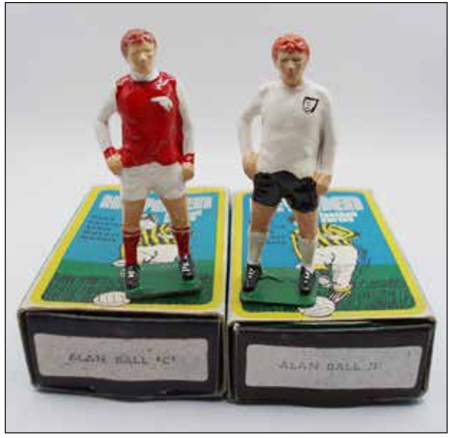
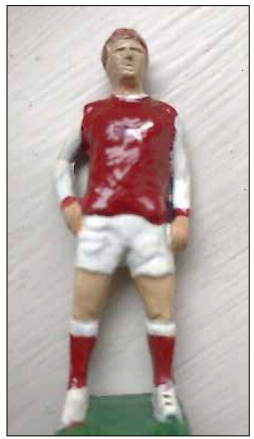
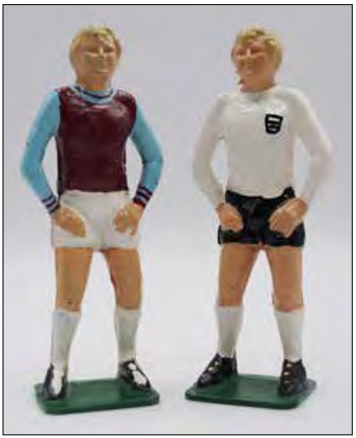
For the new 1971-2 football season, Manchester United changed their home kit and KEYMEN had to change with it, giving a new variant for Best and Charlton, (Fig 32).
But by 1972 it would appear that KEYMEN stopped producing figures. The quality was poorer, whether by the Pontefract move or just by using cheaper materials it is unknown.
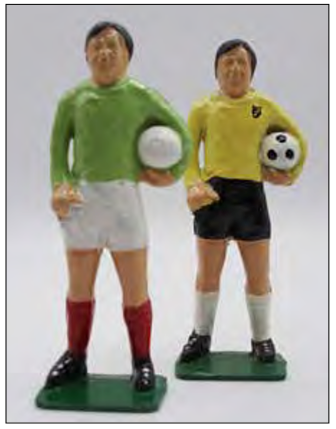
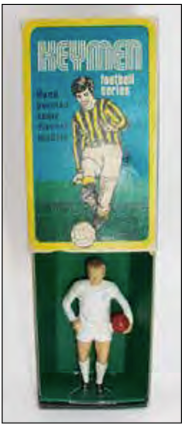
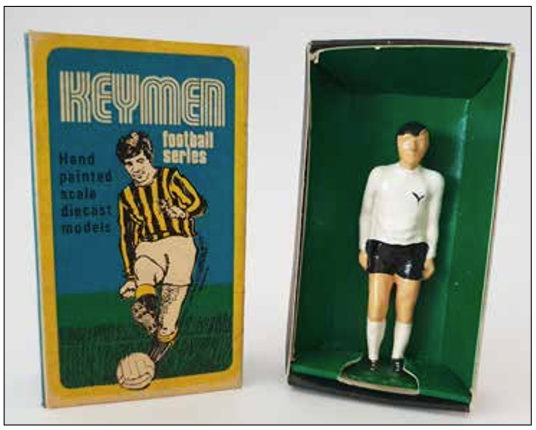
The later models suffered from cracking, they obviously were not produced in such high numbers and they were never presented in their International colours. morti_i, an eBay seller, managed to obtain the remaining stock from Mr Platt’s family and has been selling these items for some time (and still has some items available) but did find within this stock, some figures painted in silver and some in a bronze colour.
The figures were superbly sculpted, and very well painted, and probably if the company had not had a problem with the cracking, it is possible we could have had at least another series. But Mr Mitchell and Mr Platt must have been delighted with the models they produced.
Acknowledgements
This article was only possible with help from the following people: Ian Mortimer, David Edwards, Norman Joplin, Pauline Jones Local Studies Advisor Trafford Council, Stephanie Alder of MCFC and the MUFC Museum.
